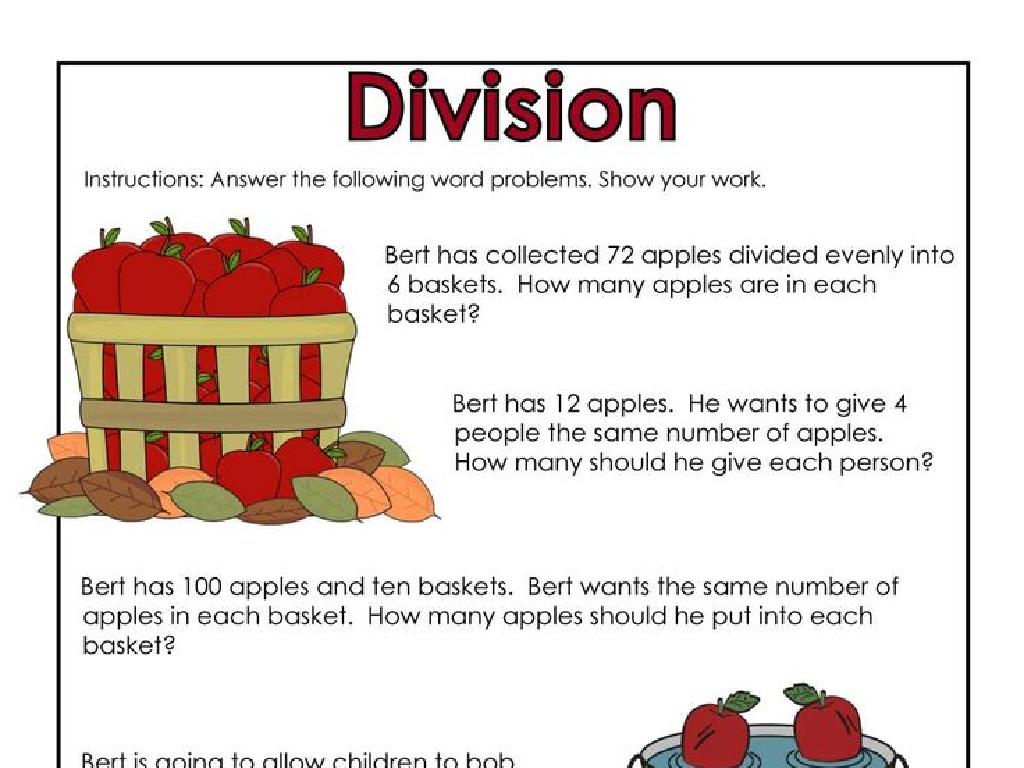Identify Functions Of Plant Cell Parts
Subject: Science
Grade: Eighth grade
Topic: Cells
Please LOG IN to download the presentation. Access is available to registered users only.
View More Content
Welcome to the World of Cells!
– Cells: Life’s building blocks
– Plant cells’ role in nature
– Plants use cells to grow, reproduce, and perform photosynthesis.
– Exploring plant cell parts
– We’ll look at cell walls, chloroplasts, vacuoles, and more.
– Functions of each cell part
– Learn how each part contributes to the cell’s life and health.
|
This slide introduces the fundamental concept of cells as the building blocks of all life, emphasizing their importance in plants. Highlight how plant cells differ from animal cells, particularly in their role in photosynthesis and supporting the plant’s structure. The lesson will cover key parts of the plant cell, such as the cell wall, chloroplasts, and vacuoles, and explain the function of each. Encourage students to think about how these tiny structures work together to keep plants alive and healthy. This overview sets the stage for a detailed exploration of plant cell anatomy and physiology.
Exploring Plant Cells
– Define a plant cell
– Basic unit of life in plants, contains chloroplasts unlike animal cells
– Plant vs. animal cells
– Plant cells have cell walls and chloroplasts, animal cells do not
– Main parts of a plant cell
– Cell wall, membrane, nucleus, chloroplasts, vacuole, and mitochondria
– Functions of cell parts
– Each part plays a role in cell survival and function
|
This slide introduces students to the concept of a plant cell, highlighting its unique features compared to animal cells. Emphasize the presence of a cell wall and chloroplasts, which are key differentiators. Provide an overview of the main parts of a plant cell, including the cell wall, cell membrane, nucleus, chloroplasts, central vacuole, and mitochondria, and briefly discuss their functions. The cell wall provides structure and support, the chloroplasts enable photosynthesis, the vacuole stores nutrients and waste products, and the mitochondria are the powerhouses of the cell. This foundational knowledge sets the stage for a deeper dive into the roles each part plays in the life of a plant.
Plant Cell: The Cell Membrane
– Protective barrier of the cell
– Regulates substance movement
– Controls what enters/exits the cell, like a gatekeeper
– Supports cell structure
– Maintains the cell’s shape and integrity
– Facilitates cell communication
– Helps cells coordinate with each other
|
The cell membrane is a crucial component of plant cells, acting as a protective barrier that maintains the integrity of the cell. It’s selectively permeable, meaning it carefully controls which substances can enter or leave the cell, thus regulating the internal environment. This regulation is vital for the cell’s survival and function. The cell membrane also provides structural support, helping to maintain the cell’s shape, and it plays a role in cell communication, allowing cells to interact and coordinate their activities, which is essential for the overall health and growth of the plant.
Exploring the Cytoplasm
– Cytoplasm: a jelly-like fluid
– It’s the substance filling the cell, excluding the nucleus.
– Contains organelles and cell parts
– Organelles like mitochondria and ribosomes are suspended in it.
– Site of cellular activities
– Metabolic processes like glycolysis occur here.
– Essential for cell functions
|
The cytoplasm is a thick solution that fills each cell and is enclosed by the cell membrane. It provides a platform upon which other organelles can operate within the cell. All the functions for cell expansion, growth, and replication are carried out in the cytoplasm. It’s important for students to understand that while the cytoplasm may seem like ’empty space’, it is actually a bustling environment where the building blocks of life are constantly being synthesized and broken down. Encourage students to think of the cytoplasm as a busy factory floor, with each organelle performing its own specialized function.
Plant Cell: The Nucleus
– Nucleus: The cell’s ‘brain’
– Directs all cell activities, similar to a control center
– Houses genetic material (DNA)
– DNA within the nucleus holds the instructions for traits and cell function
– Regulates cell growth and reproduction
– Ensures cells divide correctly and at the right time
– Manages cell metabolism
– Oversees the conversion of nutrients into energy
|
The nucleus is often referred to as the ‘brain’ of the cell because it directs cell activities and functions. It contains the cell’s genetic material, DNA, which determines the characteristics of the plant and its cellular operations. The nucleus plays a crucial role in cell growth and reproduction by controlling the cell cycle and ensuring cells divide when necessary. It also regulates metabolism, the chemical processes that occur within the plant cell to maintain life, by managing the conversion of nutrients into energy. This slide will help students understand the importance of the nucleus in the overall function of plant cells.
Exploring Chloroplasts in Plant Cells
– Chloroplasts are unique to plant cells
– They are the site of photosynthesis
– Convert sunlight into chemical energy
– Contain chlorophyll for green color
– Chlorophyll absorbs light for photosynthesis
– Essential for energy production
|
Chloroplasts are specialized organelles found only in plant cells and are crucial for the process of photosynthesis, where sunlight is converted into chemical energy for the plant’s use. They house chlorophyll, the pigment responsible for the green color of plants, which plays a vital role in absorbing light energy. Understanding chloroplasts is key to comprehending how plants produce their own food and contribute to the Earth’s ecosystem by producing oxygen. Encourage students to think about the importance of sunlight for plants and how chloroplasts enable plants to grow and thrive.
Plant Cell Structure: The Cell Wall
– Cell wall: A rigid outer layer
– It’s like a sturdy box around the soft cell parts
– Provides structure to the cell
– Supports the cell’s shape like a skeleton
– Offers protection for the cell
– Acts as a shield against physical damage
– Composed of cellulose
– Cellulose gives the wall its strength
|
The cell wall is a defining feature of plant cells, setting them apart from animal cells. It’s a rigid layer that surrounds the cell membrane, providing structural support and protection. Made primarily of cellulose, a complex carbohydrate, the cell wall is strong enough to withstand the turgor pressure from within the cell, helping to maintain the plant’s upright position. It also acts as a barrier to pathogens and mechanical stress. When discussing the cell wall, use analogies like a suit of armor or a rigid box to help students visualize its function. Encourage them to think about how the cell wall contributes to the overall health and stability of a plant.
Understanding Plant Cell Vacuoles
– Vacuoles: Large storage sacs
– Stores water, nutrients, and waste
– Maintain cell’s shape
– Provides structural support
– Central vacuole in plants
– Key for plant cell’s structure and function
– Occupies up to 90% of volume
|
Vacuoles are essential components of plant cells, acting as storage centers for water, nutrients, and waste products. They play a crucial role in maintaining the cell’s shape by exerting turgor pressure against the cell wall. The central vacuole is particularly significant in plant cells, where it can take up to 90% of the cell’s volume, contributing to the cell’s rigidity and enabling it to support the plant’s structure without the need for a skeletal system. During the presentation, highlight the importance of vacuoles in regulating the cell’s internal environment and their role in plant growth and stability.
Mitochondria: The Powerhouse of the Cell
– Mitochondria as power generators
– They produce ATP, the energy currency of the cell, through respiration.
– Conversion of food to energy (ATP)
– Glucose from food is broken down and transformed into ATP.
– Role in cell growth
– Mitochondria supply energy for cells to grow and divide.
– Involvement in cell death
– They release enzymes that can trigger programmed cell death.
|
Mitochondria are essential organelles often referred to as the powerhouse of the cell because they generate most of the cell’s supply of adenosine triphosphate (ATP), used as a source of chemical energy. In addition to energy production, mitochondria are involved in a range of other processes, including cell growth and the signaling of cell death, known as apoptosis, which is necessary to maintain the health of the organism. When discussing the mitochondria’s role in cell growth and death, emphasize the balance and regulation required for proper cellular function. Provide examples of how mitochondrial dysfunction can lead to diseases, reinforcing the importance of these organelles in overall cell health.
Plant Cell Functions: A Holistic View
– Review plant cell part functions
– Recap: nucleus directs, chloroplasts create food, mitochondria power cells.
– Synergy of cell components
– Like a team, each part performs tasks that support the others.
– Cell parts’ role in plant health
– Healthy cells mean a thriving plant, from roots to leaves.
– Analogy to a city’s infrastructure
– Compare cell parts to city structures working together for the community.
|
This slide aims to consolidate students’ understanding of individual plant cell parts and emphasize the interconnectedness of these components. By reviewing the roles of the nucleus, chloroplasts, mitochondria, and other organelles, students can appreciate how each part contributes to the cell’s overall function and, consequently, the plant’s health. Drawing an analogy to a city’s infrastructure, where different structures have specific functions but work together for the city’s benefit, can help students visualize the concept of synergy within the plant cell. Encourage students to think of other analogies and discuss how a malfunction in one cell part might affect the entire cell and plant.
Class Activity: Build a Plant Cell Model
– Create a 3D plant cell model
– Label cell parts and functions
– Present and explain cell parts
– Discuss the role of each part
|
In this hands-on activity, students will use various materials to construct a three-dimensional model of a plant cell. They will need to accurately label each part of the cell, such as the cell wall, chloroplasts, vacuole, and nucleus, and include a brief description of its function. After completing the model, students will present their creation to the class, explaining the role of each cell part in maintaining the life and health of the plant. This activity will help solidify their understanding of plant cell anatomy and the functions of its components. Possible materials include clay, gelatin, and various household items. Encourage creativity and ensure that each student or group can articulate the function of each cell part clearly.






